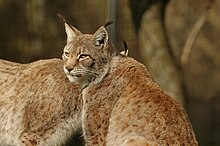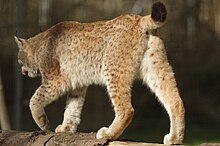The Turkestan lynx (Lynx lynx isabellinus), also known as the Central Asian, Tibetan or Himalayan lynx, is a subspecies of the Eurasian lynx (Lynx lynx) distributed in Central Asia and in the Himalayas.
| Turkestan lynx | |
|---|---|

| |

| |
| Scientific classification | |
| Domain: | Eukaryota |
| Kingdom: | Animalia |
| Phylum: | Chordata |
| Class: | Mammalia |
| Order: | Carnivora |
| Suborder: | Feliformia |
| Family: | Felidae |
| Subfamily: | Felinae |
| Genus: | Lynx |
| Species: | |
| Subspecies: | L. l. isabellinus
|
| Trinomial name | |
| Lynx lynx isabellinus | |
| Synonyms | |
|
Lynx lynx tibetanus (Gray, 1863), Lynx lynx kamensis (Satunin, 1905) | |
Taxonomy
editFelis isabellina was the scientific name proposed by Edward Blyth in 1847, upon his examination of a lynx skin from Tibet.[2] Lynx lynx wardi was proposed by Richard Lydekker in 1904, though many authors considered it synonymous to L. lynx isabelinus.[3] Further investigations are needed to determine its status as a separate subspecies or not. Currently, wardi is sometimes regarded as a synonym to isabellinus.[4][1] Some findings of Kazakhstani lynx haplotypes support the classification of the Altai lynx (L. l. wardi) as a separate subspecies from Turkestan lynx (L. l. isabellinus).[5]
Distribution and habitat
editThe Turkestan lynx occurs in Kazakhstan, Uzbekistan, Turkmenistan, Kyrgyzstan, Tajikistan, Afghanistan, Pakistan, Ladakh, Nepal, Bhutan and the Tibetan region of China. It lives mostly at higher elevations, in open woodland and steppe habitats with rocky slopes, caves and multiple safe hiding places.[4] In the Indian Himalayas, individuals were sighted at an elevation of 4,900 m (16,100 ft) in Hemis National Park, and at 4,800 m (15,700 ft) on the Changtang Plateau, both in Ladakh.[6][7] In Kazakhstan, the Turkestan lynx occurs in the Tian Shan and Dzungarian Alatau Mountains, which play a significant role in maintaining the stability of the population in its northwestern range.[8]
Conservation
editThe Turkestan lynx has been protected under Schedule I of India's Wild Life (Protection) Act, 1972.[7] In Afghanistan, it is considered threatened.[9] It is listed as Near Threatened on Pakistan's and Mongolia's national Red Lists.[10][11] It is listed as Endangered in China,[12] Turkmenistan,[13] Tajikistan[14] and as Vulnerable in Nepal,[15] Kazakhstan[16] and Uzbekistan.[17]
References
edit- ^ a b Wilson, D. E.; Reeder, D. M., eds. (2005). "Subspecies Lynx lynx isabellinus". Mammal Species of the World: A Taxonomic and Geographic Reference (3rd ed.). Johns Hopkins University Press. p. 541. ISBN 978-0-8018-8221-0. OCLC 62265494.
- ^ Blyth, E. (1847). "Report of Curator, Zoological Department, for September 1847". The Journal of the Asiatic Society of Bengal. 16 (2): 1176–1182.
- ^ Wozencraft, W. C. (2008). "Genus Lynx". In Smith, A. T.; Xie, Y. (eds.). A Guide to the Mammals of China. Princeton: Princeton University Press. pp. 396–397. ISBN 978-1400834112.
- ^ a b Breitenmoser, U.; Breitenmoser-Würsten, C.; Lanz, T.; von Arx, M.; Antonevich, A.; Bao, W. & Avgan, B. (2015). "Lynx lynx". IUCN Red List of Threatened Species. 2015: e.T12519A121707666.
- ^ Bizhanova, N.; Nanova, O.; Fadakar, D.; Grachev, A.; Hong, Z.; Mohd Sah, S. A.; Bizhanova, Zh.; Sablin, M.; Grachev Yu. (2024). "Insights into subspecies classification and conservation priorities of Central Asian lynx populations revealed by morphometric and genetic analyses". Scientific Reports. 14 (1): 5186. Bibcode:2024NatSR..14.5186B. doi:10.1038/s41598-024-55807-x. PMC 10908838. PMID 38431728.
- ^ Sharma, S. & Dutta, T. (2005). "Sighting of Lynx (Lynx lynx isabellinus) in Hemis National Park, Ladakh". Zoo's Print. 20 (4): 14.
- ^ a b Kotia, A.; Angmo, K. & Rawat, G. S. (2011). "Sighting of a Eurasian lynx near Chushul village in Ladakh, India". Cat News (54): 18–19.
- ^ Bizhanova, N.; Steiner, M.; Rametov, N.; Grachev, A.; Grachev, Y.; Bespalov, M.; Zhaparkulov, T.; Saparbayev, S.; Sailaukhanuly, A.; Bespalov, S.; Bolatuly, A.; Saparov, K. & Sah, S.A.M. (2022). "The elusive Turkestan lynx at the northwestern edge of geographic range: Current suitable habitats and distribution forecast in the climate change". Sustainability. 15 (14): 9491. doi:10.3390/su14159491. This article incorporates text from this source, which is available under the CC BY 4.0 license.
- ^ Habibi, K. (2003). "Himalayan Lynx Lynx lynx isabellina (Linnaeus, 1758)". Mammals of Afghanistan. Coimbatore, India: Zoo Outreach Organization. pp. 49–50.
- ^ Sheikh, K. M.; Molur, S., eds. (2004). "Himalayan lynx Lynx lynx isabellina Blyth, 1847". Status and Red List of Pakistan's Mammals. Based on the Conservation Assessment and Management Plan (PDF). Islamabad: IUCN Pakistan. p. 230.
- ^ Clark, E.L.; Javzansuren, M.; Dulamtseren, S.; Baillie, J.E.M.; Batsaikhan, N.; Samiya, R. & Stubbe, M. (2006). "93. Lynx lynx (Linnaeus, 1758)". Mongolian Red List of Mammals. Regional Red List Series. Vol. 1. London: Zoological Society of London. pp. 95–96.
- ^ Jiang, Z.; Jiang, J.; Wang, Y.; Zhang, E. (2016). "Red List of China's Vertebrates". Biodiversity Science. 24 (5): 500–551. doi:10.17520/biods.2016076.
- ^ Annabayramov, B.; Saparmyradov, J.; Karyyeva, O.; Potayeva, A.; Atayev, K.; Kokanova, E.; Durdyev, S.; Rustamov, E. & Shammakov, S. (2011). The Red Data Book of the Republic of Turkmenistan. Vol. 2. Invertebrate and vertebrate animals (Third ed.). Ashgabat, Turkmenistan: Ilim.
- ^ Kurbonov, S. & Toshev, A. (2015). The Red Data Book of Tajikistan: Flora and Fauna (Second ed.). Dushanbe, Tajikistan: Donish.
- ^ Jnawali, S.R.; Baral, H.S.; Lee, S.; Acharya, K.P.; Upadhyay, G.P.; Pandey, M.; Shrestha, R.; Joshi, D.; Laminchhane, B.R.; Griffiths, J.; Khatiwada, A.P.; Subedi, N. & Amin, R. (2011). "Lynx lynx (Linnaeus, 1758)". The Status of Nepal Mammals (PDF). The National Red List Series. Kathmandu, Nepal: Department of National Parks and Wildlife Conservation. pp. 82–83. ISBN 9780900881602.
- ^ Grachev, Yu.A. (2010). "Lynx". In Meldebekov, A.M. (ed.). The Red Data Book of the Republic of Kazakhstan (PDF). Vol. 1. Animals. Almaty, Kazakhstan: DPS, Institute of Zoology. pp. 258–259.
- ^ Esipov A.V. (2009). "Lynx". In Azimov, J.A. (ed.). The Red Data Book of the Republic of Uzbekistan. Vol. 2. Animals. Tashkent, Uzbekistan: Chinor ENK, Uzbek Zoology Institute. pp. 192–193.